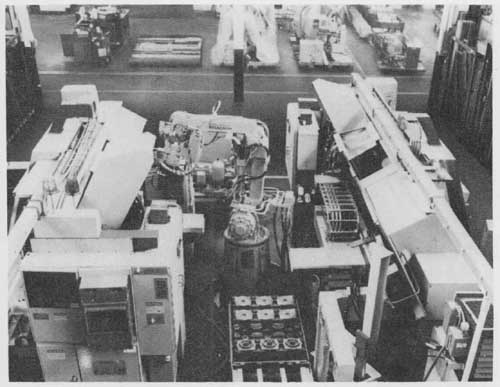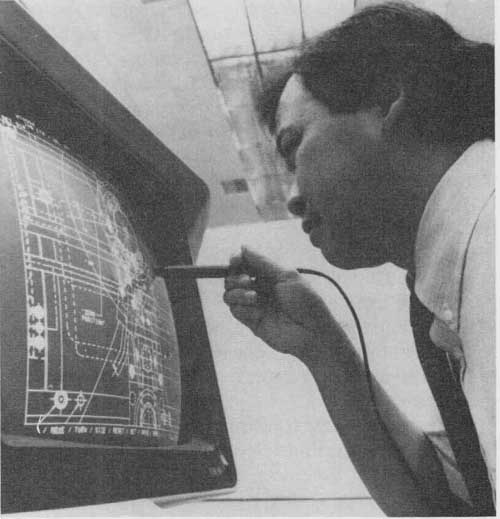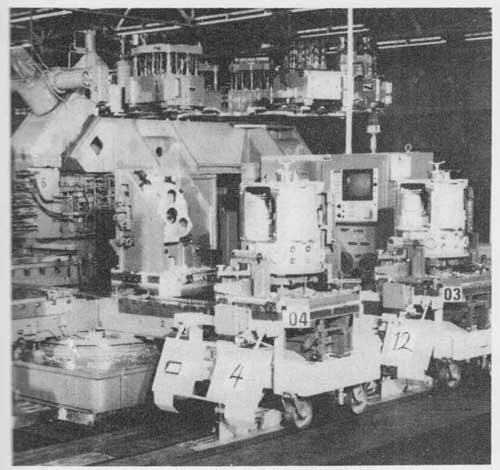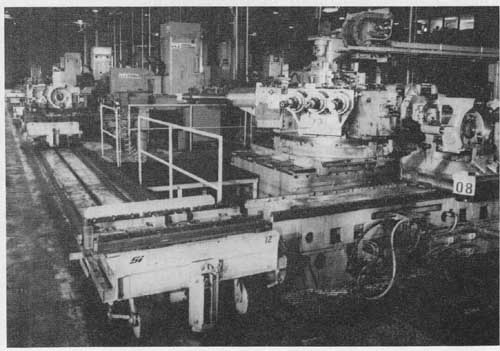AMAZON multi-meters discounts AMAZON oscilloscope discounts
Of all the manufacturing processes that can be applied to the shaping arid forming of raw materials into useful products, machining processes will always remain among the most important. The fundamental cutting processes in machining, those of bringing the work into contact with a cutting tool, are still very much in evidence and will always remain mainstays of the industry. What has changed is the way in which these processes are applied, the cutting tool materials, material used for products, and the methods of material removal. These new methods are quite different from the classical chip- producing processes. They include the use of lasers, electrical energy, electrochemical processes, ultrasound, high-pressure water jets, and high-temperature plasma arcs as material removal tools.
Computers have enhanced automated manufacturing: machining is no exception. Numerical control (NC) of machine tools has been available for many years. Today, typical machine tools of all types are equipped with their own computer numerical controls (CNCs) and almost every ma chining process can now be efficiently automated with an exceptional degree of accuracy, reliability, and repeatability. In fact, machining processes have become so sophisticated and re liable that the human operator of a machine tool may now be replaced with a robot (FIG. A-1). This application of computer-driven automated equipment will profoundly affect the employment of machinists and machine operators in future years.
The computer has found its way into almost every other phase of manufacturing as well. One important area is computer-aided design (CAD) (FIG. A-2). The age of drawing board de sign is fast drawing to a close. Design is now done on computer terminals and manufacturing equipment control programs are generated directly in computer-aided manufacturing ( CAM ), or fully computer-aided design and manufacturing (CAD/CAM), or computer-integrated manufacturing (CIM).
The ultimate outcome of manufacturing automation will be an entirely automated factory in which material will be automatically transported between manufacturing cells that will perform similar manufacturing or machining operations. Such a system, called a flexible manufacturing system (FMS), will be fully computer controlled and already has become an industry standard (FIGs A-3 and A-4).

FIG. A-1 The machine operator of tomorrow’s automated manufacturing industry.
A computer-controlled industrial robot loads and unloads parts on a CNC turning
center (Cincinnati Milacron).
Career Opportunities in Machining and Related Areas
The influence of high technology in machining manufacturing has had, and will continue to have a significant effect on the types and numbers of jobs available in this field. Many exciting career opportunities are available for those willing to prepare themselves. However, like all technology, machining manufacturing has become a very specialized business and this trend is likely to continue.
TRADE LEVEL OPPORTUNITIES
MACHINE OPERATOR The machine opera tor will be widely employed for some time to come. The machine operator’s responsibilities will be to operate computer-driven (CNC) ma chine tools such as turning or machining centers. The operator will observe machine functions and tool performance, change and inspect parts, and perhaps have some limited duties in setting up and adjusting machine programming.
Preparation for machine operator will consist of familiarization with conventional machining processes, tooling selection and application, machine control unit operations, reading drawings, related math, limited machine setup, and quality control inspection measurement functions. The machine operators can receive training through trade schools, community college programs, or industrial training programs, or they may learn on the job. The CNC operator will generally work in a fast-paced production environment in companies ranging in size from very small to very large.

FIG. A-2 Computer-aided design (CAD) is fast re placing the drawing board
in engineering design applications (Cincinnati Milacron).
SETUP The setup person is responsible for setting up the machine tool and assisting the operator in establishing a first article acceptable part at the start of production. Setup people will generally have considerable CNC experience at the operator level and will be very familiar with jigs, fixtures, cutting tools, and CNC program operations. The setup person is most likely to learn the work through on-the-job training. Setup people will also work in fast-paced production shops, in medium-sized to large companies.
GENERAL MACHINIST The general machinist will have the capability to set up and operate all of the common conventional machine shop equipment. This person may receive training through an industrial apprenticeship lasting about four years, through broad-scope community college and trade school education often tied to a local machining industry, or through on- the-job experience of several years. The general machinist is not exactly disappearing, but much of the production work heretofore done by this individual can now be routinely accomplished on CNC machine tools by machine operators.
The general machinist may work in a job shop environment where many different types of work are performed. In a large company where modeling and prototyping are accomplished, the general machinist will find varied and extremely interesting work.

FIG. A-3 A specialty CNC machining center forms o work cell in a flexible
manufacturing system (FMS). Robot transporters move parts from cell to cell
all under computer control ( Kearney and Trecker Corp.).

FIG. A-4 Parts to be machined are mounted on pallets so that they may be
moved from machining center to machining center in different work cells in
+e flexible manufacturing system (Kearney and Trecker Corporation).
AUTOMOTIVE MACHINIST The automotive machinist will work in an engine rebuilding shop where engines are overhauled. This individual’s responsibilities win be somewhat like those of the general machinist, with specialization in engine work including boring, milling, and some types of grinding applications. Training for this job may be obtained on the job or through college or trade school programs.
MAINTENANCE MACHINIST The maintenance machinist has broad responsibilities. This individual may be involved in plant equipment maintenance, machine tool rebuilding, or general mechanical repairs including welding and electrical. The maintenance machinist is often involved with general machine shop work as well as with general industrial mechanical work. The general maintenance machinist is often a vital member of the manufacturing support team in industries of all sizes. This individual may receive training through college and trade school programs or on the job.
TOOL, DIE, AND MOLD MAKER The tool, die and mold maker is often considered to be at the upper end of the machinist trade occupations. These individuals are essential in almost every machining manufacturing industry. The tool and die maker will usually be an experienced general machinist with superior talents developed over a number of years of shop apprenticeship and more years of experience. Tool and die makers may receive training through industrial apprenticeships or college and trade school programs. They may also be selected for industrial training in companies large enough to have an in-house tool and die shop. Although these individuals are often chosen only alter several years of on-the-job experience, it is possible to start out in tool and die work through an apprenticeship program. Tool and die makers often receive premium pay for their work and will be involved with many high-precision ma chining applications, tool design, material selection, metallurgy, and general manufacturing processes.
INSPECTOR Inspectors will be necessary to handle the dimensional measurement quality control functions. Many of these individuals will become inspectors alter some time as machine operators, general machinists, or possibly tool makers. The machined parts inspector of today will require a knowledge of computerized measurement equipment (FIG. A-3). Inspectors may be trained on the job or through college and trade school programs.
PRODUCTION TECHNICIANS Production technicians will be involved in many different tasks in machining manufacturing industries.
Some of these responsibilities relative to maintenance may be similar to those of the maintenance machinist. The production technician will be responsible for installation of production equipment. Both electrical/electronic and mechanical technicians will be needed as manufacturing industries shift toward more computer- integrated manufacturing. The technician, especially in the electrical/electronic areas, will need excellent diagnostic skills so that expensive equipment can be quickly serviced and returned to production. Technicians may obtain training through college and trade school programs or on the job. Areas of knowledge will include pneumatics, hydraulics, electrical/electronic systems, computers, and the interrelationships of all these systems in complex manufacturing systems.
MARINE MACHINIST The marine machinist is generally employed in the shipbuilding industry. This trade has many different aspects, including installation, testing, and repairs of all types of shipboard mechanical systems, including hydraulics and pneumatics as well as conventional and nuclear steam systems. The marine machinist may also use portable ma chine tools that are brought to the job, including milling, boring, and drilling machines. Marine machinists often use optical instruments to align and locate mechanical components and machine tools.
APPRENTICE MACHINIST -- The apprentice machinist learns the trade by entering a formal training program sponsored by private industrial, trade union, or government entities. The period of training is typically four years long and is a combination of on-the-job experiences and for mal classroom education. Apprenticeship curriculum standards are often quite universal, representing the collective inputs of all levels of the trade from production through management. Serving an apprenticeship represents one of the best and well-established methods of learning a skilled trade.
HELPERS AND LIMITED MACHINISTS
Many manufacturing industries use limited machinists or machinists’ helpers. These individuals assist the journeyperson by providing general help. These trades are often fairly low skill since the person does not have full responsibility for the work at hand. However, helpers and limiteds may be able to advance to journeyman status alter a suitable training period.
PROFESSIONAL CAREER OPPORTUNITIES
At the professional level, many exciting career opportunities are also available. These careers will require college preparation and include industrial technology (IT); industrial engineering (IE); manufacturing engineering; materials engineering; mechanical, electrical, electronic, and computer systems engineering; and CNC programming.
The industrial engineer, industrial technologist, and manufacturing engineer are often involved with the applications of manufacturing technology. These individuals design tooling, set up manufacturing systems, apply computers to manufacturing requirements, and write CNC programs.
Design engineers, often using computers, de sign products and manufacturing equipment and apply new materials in product design.
Machining and You
Whether a career in machining or a related area is for you will depend on your personal goals and how much effort you are willing to expend in preparation. No matter which area you might like to pursue, whether it be at trade or professional level, a working knowledge at the shop level of the machining processes and the related subjects described in this text will provide an excellent basis on which to build an exciting career in industrial manufacturing technology.
UNITS IN THIS SECTION
The units in this section deal with the important areas of safety in the machine shop, mechanical hardware, and reading shop drawings. These fundamental technical foundation areas are necessary for anyone involved in any phase of mechanical technology. To start off your study in the proper way, take the time now to familiarize yourself with these important fundamentals.